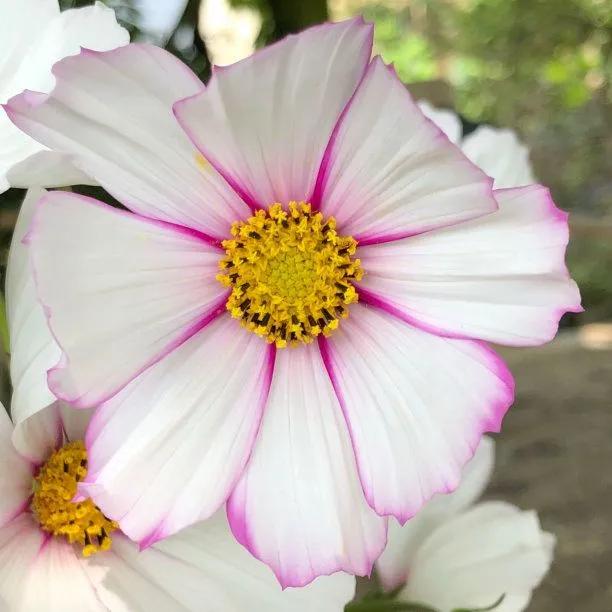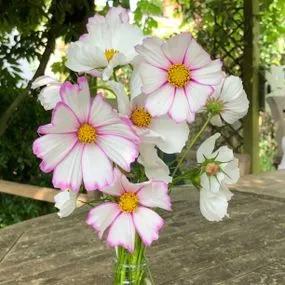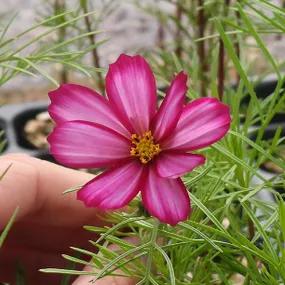Candy Stripe Cosmos Seedling Plants
Honest Delivery Prices- Half-hardy Annual
- Colour: White with pink edges
- Height: 120cm
- Planting Months: May to July
- Flowering: June to November
- Plant Spacing: 30cm
- Foliage: finely cut
Description
Cosmos Candy Stripe
Cosmos bipinnatus Candy Stripe is one for planting towards the back of a border, as it will reach over 1m tall. Its flowers are large and gorgeous, a sweet confection of white daisy-like petals, the edges dipped in a deep raspberry glaze. Bees and other pollinators love its simple, open flowers, all the better for nectar-gathering. There are more compact varieties of cosmos, too, if you fancy something for pots and containers on the patio – take a look at our full range of cosmos seedlings. Cosmos are famed for their long flowering season, and this variety is no exception – it'll carry on producing flowers from early summer right until the cold days of November, as long as you do it a favour and keep deadheading. It's best to do this not just by nipping off the spent flowerhead but part of the stem, too, down to the first set of leaves. Candy Stripe also makes a great cut flower for bringing indoors for vases.
Sweet treats
Cosmos look fantastic planted en masse, in big, bold groups. Candy Stripe would look fabulous combined in drifts with deep pink Sonata Carmine, for example, or as a contrast to the ruffled pink petals of Double Click Cranberries. Or combine with classic cottage garden favourites such as lavenders, shrub roses (the deep pink of Tuscany Superb would be a perfect match) or salvias. When planting, think a little about your soil type. If you garden on clay, improve the drainage with compost or manure. And if you have a problem with slugs and snails, wait until your seedlings are strong and sturdy before planting them out. Feed weekly with something like Tomorite, and you'll have flowers that go on and on.
Candy Stripe in brief
- Half-hardy Annual
- Colour: White with dipped pink edges
- Height: 120cm
- Planting Months: April to June/July
- Flowering: June to October
- Plant Spacing: 30cm
- Foliage: finely cut, filigreed
Planting Instructions
Plant Cosmos Candy stripe in well prepared, moist soil that ideally was enriched with a little organic matter the previous autumn. Not too much as Cosmos flower better if the soil is not overly rich. Water well after planting and for at least a week after that just to make sure they establish well.
Cosmos also grow very well in containers but remember that they can reach 100 cms in ideal conditions, so we would suggest using pot sizes of at least 5 Litres and preferably a bit more. Any general purpose compost will do here.
The main requirements are that your plants have enough light and water - they grow very fast and flower hugely through summer, so moisture is important. They can cope with a little shade but flower better in full sun. In general, they need an absolute minimum of 4 hours direct light a day, but 6-8 hours would be better.
Because you are buying seedlings, you can plant your cosmos into their final flowering positions immediately. Space your plants 35-50 cm apart and (in a bed) plant them in drifts of rather than singly. They will either need a 90 cms cane per plant (which should be pushed in about 30 cms deep and about 5 cm from a plant) or a support made of twine or pea/bean netting. This should be stretched between canes about 40 cms above ground level and the cosmos can then grow through it. It is not pretty at first but the plants disguise it very quickly, and it is an effective solution (if you are anti-plastic, you can also make a cat's cradle of twine between canes around the outside of the planting). Just don't plant a group that is so big you can't reach the middle...
As flowers develop cut them or dead head when they are over and your cosmos will carry on flowering all summer long. A well-grown plant can quite literally produce a hundred flowers or so in a season.
To maintain flower quality and size, you can use a high potash and phosphate fertiliser every fortnight throughout summer Home-made comfrey tea is perfect or one of the specialised tomato fertilisers will do very well.




